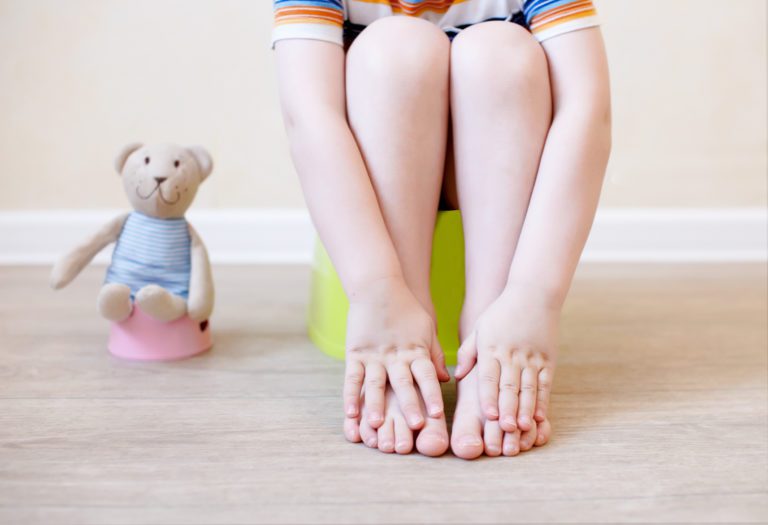
Treatment for Pediatric Constipation, Bed Wetting, & Leakage
You would never imagine that bowel movements and urination would become a daily topic of conversation…until you have kids. It’s instantly the norm to pay attention to whether the baby went poop each day, what it looked like, how many times, etc. As a child grows a few years older, the questions change, but the topic stays the same – “Do you have to go potty?”, “Does your stomach hurt?”, “When was the last time you went?” etc.
When your child has constipation or bedwetting issues, it can be challenging to diagnose correctly. As a parent, you can’t help but wonder if this is just a normal part of growing up or if you should be concerned.
By six years old, most children should have complete control of their bowel and bladder function. Yet, it is estimated that up to 20% of pediatric healthcare visits revolve around bladder and bowel problems, and up to 25% of children visiting a pediatric gastroenterologist experience bouts of constipation or encopresis (bowel leakage or soiled undies).
These issues can be frustrating for both parents and children. But help is available through pediatric pelvic floor physical therapy – a safe and effective treatment option for infants, toddlers, and children.
Common pediatric pelvic floor issues include:
Pediatric bed wetting & daytime incontinence – Most children begin to stay dry the entire night between the ages of 3 and 5. The primary reason for nighttime leakage is constipation, followed by not fully emptying during the day. Our bodies are designed to hold urine, and children should not have to urinate at night.
Pediatric Constipation – Constipation is one of the most common gastrointestinal complaints among children but can also contribute to urinary leakage or the urgency to go. Pediatric bladder and bowel dysfunction can continue well into adulthood, so getting this taken care of early on is important. Contributing factors to constipation include: diet, emotional issues, and sometimes busy children simply ignoring the signs that they have to go.
Diastasis Recti – A common issue in infants, especially those born prematurely, diastasis recti is a separation between the left and right side of the rectus abdominis muscle, which is the muscle that covers the front surface of the belly. This can also lead to poor trunk control, affecting the bowels.
Other diagnoses that affect the pelvic floor in children – voiding dysfunction (when your child’s bladder is not emptying, or they are not urinating normally or fully), urinary urgency and frequency, vesicoureteral reflux (backflow of urine into the kidney), and pelvic pain.
Treatment for pediatric pelvic floor issues
Physical therapy can be a safe and effective way to help a child gain control of their bladder. Focusing on a group of muscles and soft tissue, called the pelvic floor, supports the pelvic organs and helps control bladder function. When these muscles are too tight, too weak, or in spasm, it can cause problems in children because the pelvic floor muscles aren’t working well with the bladder.
Children experiencing bladder and bowel control issues may be more prone to bladder infections, constipation, difficulty sensing when the bladder is full, or other problems resulting from not completely emptying the bladder. This can also lead to urinary or bowel leakage and wetting during the day or night.
Pediatric pelvic floor treatment techniques may include:
- Biofeedback – Helping children learn to strengthen or relax their pelvic floor muscles to improve bowel or bladder function and decrease pelvic floor pain
- Behavioral and diet modification
- Soft tissue mobilization – Using hands-on techniques on muscles, ligaments, and fascia to optimize muscle function
- Stretching and strengthening of the pelvic floor and surrounding muscles
- Relaxation techniques
Physical therapy may help if:
- A child is five years or older and still wears pull-ups
- Medication is needed for bladder or bowel control
- Urinary incontinence or leakage
- Bedwetting (nocturnal enuresis)
- Laughing causes urine leakage
- Frequent urination or overactive bladder
- Infrequent urination or underactive bladder
- Constipation/diarrhea, painful bowel movements, over/underactive bowels
With a parent present, a physical therapist with specific training in pediatric pelvic floor therapy will examine the abdomen, pelvis, and pelvic floor area muscles. Consultation and treatment often consist of:
- Muscle retraining
- Biofeedback
- Patient and family education
- Behavior and diet modification
- Soft tissue massage
- Stretching
- Strengthening the pelvic floor and surrounding muscles
- A home exercise program
If you feel your child may suffer from pelvic floor dysfunction, we can help. Visit our pediatric incontinence and bedwetting page to see which locations offer treatment or to request an appointment online.
Get more information about pediatric incontinence and pelvic floor dysfunction from Herman & Wallace, the pelvic rehabilitation institute.
The medical information contained herein is provided as an information resource only, and does not substitute professional medical advice or consultation with healthcare professionals. This information is not intended to be patient education, does not create any patient-provider relationship, and should not be used as a substitute for professional diagnosis, treatment or medical advice. Please consult with your healthcare provider before making any healthcare decisions or for guidance about a specific medical condition. If you think you have a medical emergency, call your doctor or 911 immediately. IvyRehab Network, Inc. disclaims any and all responsibility, and shall have no liability, for any damages, loss, injury or liability whatsoever suffered as a result of your reliance on the information contained herein.